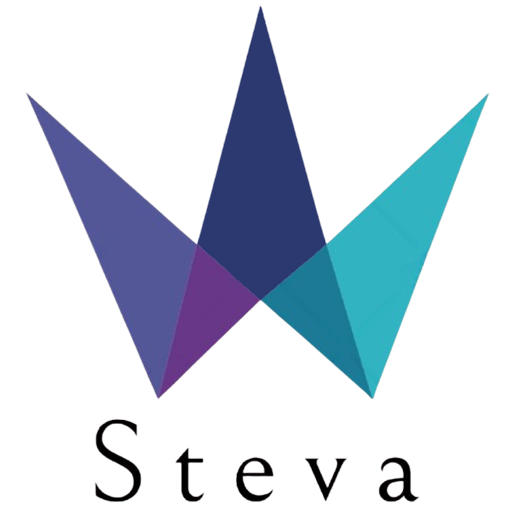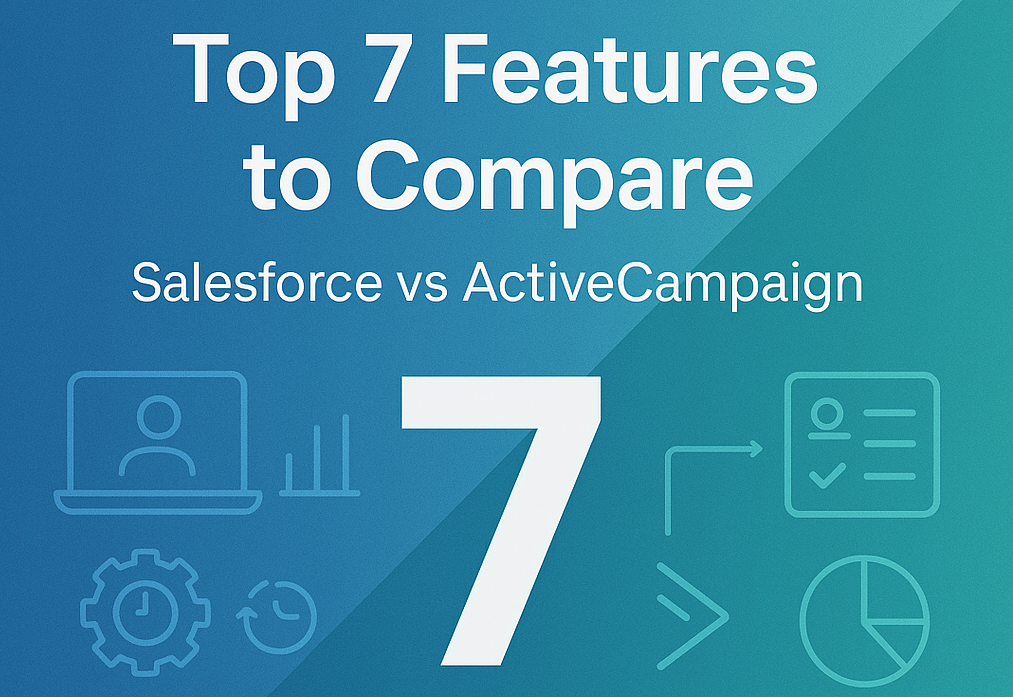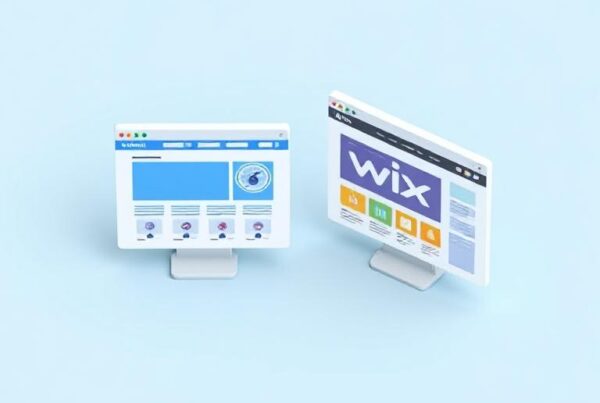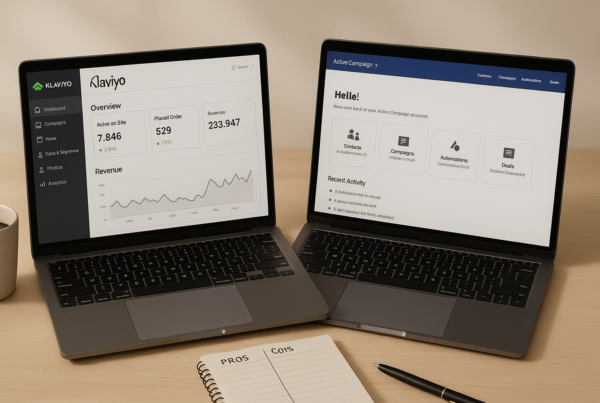When searching for the ideal marketing and CRM solution, choosing between Salesforce vs ActiveCampaign may be overwhelming. ActiveCampaign leads with a 93.4% email deliverability rate and a 4.5-star user rating. Salesforce follows closely with a 4.4-star rating and delivers an enterprise-level marketing suite integrated with a robust CRM.
Understanding the platforms’ strengths is key when comparing them. Is ActiveCampaign a CRM? Yes, but it is designed for affordability and user-friendliness, ideal for small to mid-sized businesses. For a comprehensive analysis of its features and capabilities, check out our detailed ActiveCampaign review. Salesforce offers a customizable, scalable CRM built for large enterprises with complex workflows. It is a strong choice for growing, sophisticated organizations.
ActiveCampaign shines with its simple interface and strong automation tools. Salesforce Marketing Cloud targets enterprise users, providing advanced marketing features and CRM depth and considering Salesforce vs ActiveCampaign cost, this GUI. In that case, we will clarify pricing differences and help businesses of all sizes choose the right solution.
In this detailed comparison, you’ll discover the seven most important features to evaluate when choosing between these two marketing automation platforms. Whether you run a startup or a large enterprise, this guide will help you make the best decision for your business needs.
Comparison Table: Salesforce vs ActiveCampaign
| Feature | ActiveCampaign | Salesforce |
| Starting Price | $15/month (Starter – 500 contacts) | $2,750/month (Marketing Cloud Growth – 10,000 contacts) |
| Mid-tier Price | $49/month (Plus) | Not specified |
| Premium Price | $145/month (Enterprise) | $15,000/month (Premium – 75,000 contacts) |
| Sales CRM Cost | Included in plans with add-on options | $25-$330/user/month (Sales Cloud) |
| Contract Terms | Monthly or annual payment options | Annual contracts required |
| Hidden Costs | Not mentioned | Implementation fees, Support costs (20-30% of license fees), Data storage limits, API call limits, Add-on feature costs |
| Feature Access | Basic features available in all tiers | Advanced features restricted to higher tiers |
| AI Capabilities | Included in base plans | Additional $50-150/user/month |
| Data Migration | Free with Pro or Enterprise plans | Additional consulting services required |
| Support Level | 24/7 live chat and email support included | Varies by plan, additional cost for Premier Success |
| Target Market | More cost-effective for SMBs | Designed for enterprise-level budgets |
Marketing Automation: Workflow Builders and Triggers
Marketing automation stands as the backbone of effective digital marketing campaigns. ActiveCampaign and Salesforce provide powerful automation tools yet approach workflow building and trigger implementation quite differently.
Visual Automation: ActiveCampaign vs Salesforce Journey Builder
ActiveCampaign pioneered the visual marketing workflow approach with its intuitive Automation builder, which has been a core feature since the platform’s release. The drag-and-drop interface allows marketers to create complex, multi-step campaigns without coding knowledge.
Additionally, ActiveCampaign provides an extensive catalog of pre-developed Automations called “Recipes,” which serve as templates for common marketing workflows.
Salesforce, meanwhile, offers Journey Builder in its Marketing Cloud platform, allowing for sophisticated multi-channel customer journeys across email, mobile, social, and web platforms. However, there’s a significant cost consideration: Salesforce’s basic Growth tier doesn’t include advanced automation features.
To access Journey Builder, you must upgrade to their Plus tier, which costs $2,750 monthly. It represents a significant difference in the Salesforce vs ActiveCampaign cost structure, as ActiveCampaign includes its visual automation builder in all plans.
Behavioral Triggers and Conditional Logic
Triggers are the foundation of marketing automation, specific actions or events that initiate automated workflows. ActiveCampaign offers numerous trigger options across all plan levels, including:
- Contact-based triggers (subscribes to list, unsubscribes, submits form)
- Email engagement triggers (opens the email, clicks the link, forwards email)
- CRM triggers (deal created, stage changed)
- E-commerce triggers (makes purchase, abandons cart)
Salesforce Marketing Cloud uses behavioral triggers in Journey Builder to respond to customer actions. These triggers can include abandoned carts, form submissions, or purchase events. Both platforms allow for conditional logic, which ActiveCampaign calls “conditions” and Salesforce refers to as “rules,” to create branching paths based on subscriber behavior.
ActiveCampaign permits contacts to enter automation through the same trigger up to 10 times in a 24-hour window, providing flexibility for recurring customer actions.
A/B Testing in Automation Sequences
Testing capabilities vary significantly between the platforms. ActiveCampaign allows you to A/B/C/D/E test entire workflows to determine which sequence performs better. It means you can simultaneously test different email paths, timing, or messages and compare which version drives more engagement or conversions, optimizing the complete customer journey.
When comparing testing capabilities across different platforms, you might also want to explore our ConvertKit vs ActiveCampaign comparison to see how ActiveCampaign’s testing features stack up against other marketing automation tools.
Conversely, Salesforce’s Growth tier offers more limited A/B testing options focused primarily on email optimization. You can create two versions of an email to test different elements like subject lines, copy, or images on a segment of your audience. Once you’ve established a “winner” criteria based on open or click rates, the system automatically sends the winning version to the remaining audience.
AI Campaign Builder vs Einstein AI
ActiveCampaign’s AI helps you create entire campaigns with intuitive tools. It builds automation, generates images, and personalised emails using machine learning based on user behavior, all with minimal manual effort. It improves engagement and saves marketers valuable time.
- AI-built automation
- Personalized email content
- Automatic image generation
Salesforce leverages Einstein AI for predictive insights, intelligent recommendations, and automated workflows. It enhances lead scoring, forecasting, data entry, and even sentiment analysis through natural language processing. However, advanced AI features require higher pricing tiers, affecting many businesses’ Salesforce vs ActiveCampaign cost comparison.
Both platforms offer powerful marketing automation. ActiveCampaign emphasizes accessibility for businesses of any size. At the same time, Salesforce provides deeper enterprise functionality at a higher price point and learning curve. Your best option depends on your business size, AI needs, and budget flexibility.
CRM Capabilities: Built-in vs Enterprise-Grade
Customer relationship management capabilities differ substantially between these two platforms. While Salesforce was built primarily as a CRM system, ActiveCampaign evolved from marketing automation into offering CRM functionality. This fundamental difference shapes how each platform approaches sales management.
Is ActiveCampaign a CRM?
The simple answer is yes, ActiveCampaign includes a dedicated CRM add-on integrated directly into the platform. Unlike standalone CRM solutions, ActiveCampaign’s approach centers around contact management, allowing you to store and organize customer data in a central location. This tight integration between marketing and sales data creates a seamless connection that many businesses find valuable.
ActiveCampaign has earned a strong 4.5-star rating from 60 reviews, indicating high user satisfaction with its CRM capabilities. The platform particularly excels for small to mid-sized businesses seeking an all-in-one solution without the complexity of enterprise systems.
One limitation is that as your business scales with many deals and contacts, ActiveCampaign’s CRM can become cumbersome. Many larger sales teams now opt to integrate with Salesforce instead.
Pipeline and Deal Management
ActiveCampaign provides visual pipeline management through customizable Kanban-style boards. This visual approach allows you to track leads from awareness through conversion with drag-and-drop functionality. You can create multiple pipelines with unique stages for different products, services, or departments, providing flexibility for various sales processes.
In ActiveCampaign, a “deal” represents an opportunity or lead that must be connected to at least one contact. Deals can be automatically created and modified based on data collected from contacts through marketing automation.
Salesforce, created as a CRM-first platform, offers more robust pipeline management through its Pipeline Inspection feature. It consolidates key metrics, deal changes, and AI-powered insights into a comprehensive view. For enterprise-level organizations tracking complex sales processes across large teams, Salesforce provides deeper customization options and reporting capabilities.
Lead Scoring and Assignment Rules
Lead scoring represents a significant strength in both platforms. ActiveCampaign’s lead scoring helps identify promising opportunities based on prospects’ actions and behaviors. Subsequently, you can set up automation to create deals in the CRM once contacts reach predetermined scoring thresholds.
The system allows for sophisticated scoring approaches:
- Engagement scoring based on email opens, clicks, and website visits
- Deal scoring to prioritize opportunities by value and likelihood of close
- Win probability scores using AI to analyze which deals are most likely to convert
Salesforce similarly offers advanced lead scoring but adds enterprise-grade lead management capabilities. Its system can rank leads based on interactions with marketing materials, helping sales teams prioritize high-value prospects. Primarily, Salesforce excels in complex routing rules and assignment logic for large sales organizations with territory management needs.
Salesforce CRM Integration Depth
For businesses using both platforms, ActiveCampaign offers seamless integration with Salesforce. This syncs contact data, campaign engagement, and pipeline stages across systems. It allows marketing and sales teams to maintain consistency, improve collaboration, and align workflows between both platforms efficiently.
A significant benefit is Salesforce Pipeline Sync. When sales teams update a deal stage in Salesforce, the change is reflected instantly in ActiveCampaign. It keeps pipelines aligned and ensures marketing actions match sales activity, creating a more responsive and unified customer journey experience.
From a Salesforce vs ActiveCampaign cost perspective, this integration offers flexibility. Small businesses can start with ActiveCampaign’s affordable CRM and add Salesforce later as they scale. The integration provides an economical way to bridge the two platforms without the immediate cost of full Salesforce adoption.
Email Marketing Tools and Personalization
Effective email marketing relies heavily on personalization capabilities and template design flexibility. While both ActiveCampaign and Salesforce offer robust email marketing tools, their approaches to personalization and content creation differ significantly.
Email Template Libraries: 250+ vs Custom Studio
For businesses using both platforms, ActiveCampaign offers seamless Salesforce integration. It syncs contact data, campaign engagement, and pipeline stages. This alignment helps marketing and sales teams collaborate better, ensuring a smooth and unified customer experience across both systems without extra manual syncing work.
- Sync contact and campaign engagement data
- Align sales and marketing pipelines automatically
- Improve team collaboration with unified data
A standout feature is Salesforce Pipeline Sync. When sales teams update deal stages in Salesforce, updates reflect in ActiveCampaign instantly. This ensures consistency between both platforms and keeps marketing campaigns aligned with real-time sales activity, enhancing overall customer engagement and conversion opportunities.
- Maintain accurate pipeline stages across systems
- Ensure real-time marketing and sales alignment
- Support responsive and personalized customer journeys
From a Salesforce vs ActiveCampaign cost standpoint, this integration offers flexibility. Small businesses can begin with ActiveCampaign’s affordable CRM. As needs grow, they can integrate Salesforce gradually, avoiding the immediate financial commitment required for full-scale Salesforce adoption from the start.
Dynamic Content and Conditional Blocks
Dynamic content represents a significant strength for both platforms. ActiveCampaign’s conditional content feature allows you to display or hide specific email elements based on subscriber data. This system uses a flexible set of rules centered around:
- Contact fields and tags
- Deal information
- Account and e-commerce data
- Event tracking and geolocation
For businesses evaluating email personalization capabilities across different platforms, our Klaviyo vs ActiveCampaign comparison provides insights into how these dynamic content features compare with other leading email marketing solutions.
ActiveCampaign lets you create different content blocks that display based on a contact’s interests, purchase history, or location. One notable cost difference between Salesforce and ActiveCampaign is that Salesforce charges an additional $400 per month for dynamic content capabilities, whereas ActiveCampaign includes this functionality in standard plans.
Predictive Sending vs Send Time Optimization
Both platforms offer AI-powered send-time technologies, albeit with different approaches. ActiveCampaign’s predictive sending analyzes each contact’s past engagement patterns to determine their optimal email viewing time. After enabling this feature, the system collects open activity data. It automatically queues emails to send at each recipient’s best time within a 24-hour period.
Salesforce counters with Einstein Send Time Optimization, part of its AI suite that analyzes subscriber behavior to identify ideal delivery times. In fact, ActiveCampaign sends emails randomly within 24 hours for contacts without established engagement patterns rather than defaulting to general sending times.
As a best practice when using predictive sending in automation, ActiveCampaign recommends adding a “Wait until” action after the email send step to ensure proper workflow timing.
Segmentation and Tagging Systems
Despite similarities in basic segmentation capabilities, the platforms differ in implementation. ActiveCampaign excels in granular segmentation through three primary mechanisms:
- Lists: Broad groupings that serve as the first level of segmentation
- Tags: Flexible, temporary markers for quick organization (visible only internally)
- Custom fields: Permanent, specific data points visible both internally and externally
ActiveCampaign offers seamless Salesforce integration by syncing contact data, campaign engagement, and pipeline stages. It allows marketing and sales teams to collaborate smoothly, ensuring a unified customer experience and reducing the need for manual syncing between platforms.
Salesforce Pipeline Sync instantly reflects deal stage updates in ActiveCampaign, keeping pipelines consistent. From a Salesforce vs ActiveCampaign cost perspective, this integration offers flexibility, allowing businesses to start affordably with ActiveCampaign CRM and gradually adopt Salesforce as they scale.
Reporting and Analytics: Simplicity vs Depth
Data-driven decision-making requires robust reporting capabilities. When examining Salesforce vs. ActiveCampaign, their approaches to analytics reveal fundamental differences in philosophy. ActiveCampaign prioritizes accessibility, while Salesforce emphasizes comprehensive analysis.
Campaign Performance Dashboards
ActiveCampaign’s Marketing Dashboard is your command center, displaying key metrics immediately upon login. The interface features widgets showing total contacts, contact trends over time, and your most active contacts. This dashboard provides a quick glimpse of crucial engagement metrics, including your average interaction rate (opens and clicks) across your last ten campaigns.
A standout feature is the customizable layout; you can drag and drop widgets to create a personalized view of your most important metrics. The dashboard also allows you to hide or show specific widgets based on your preferences.
Salesforce, in contrast, earns a perfect 5/5 in data reporting capabilities, according to independent research. The platform excels in data visualization tools across all plan tiers, offering custom reports, chart builders, and revenue data views that help users analyze trends quickly. This comprehensive approach enables faster data analysis and more precise business goal setting.
Custom Reports and Attribution Models
Both platforms offer robust custom reporting capabilities, yet with different focuses. ActiveCampaign’s Custom Reports feature lets you create detailed reports that provide complete views of marketing and sales activities. These reports can analyze specific questions about your data or activities, with the ability to save, share with team members, or download for further analysis.
ActiveCampaign provides reporting across five key areas:
- Contacts
- Deals
- Automation
- Campaigns
- E-commerce
In terms of attribution modeling, ActiveCampaign offers last-touch attribution through its Conversion Attribution Reports, showing which final touchpoint contributed to customer conversion. It helps assess the ROI of your marketing methods and understand which channels generate the most revenue.
Salesforce, alternatively, provides multiple built-in attribution models. These include first-touch (assigning 100% of influence to the first campaign a prospect touches), last-touch (giving full credit to the final touchpoint), and even distribution (allocating equal credit to every touchpoint). This variety allows for a more nuanced analysis of marketing impact on revenue generation.
Concerning Salesforce vs ActiveCampaign cost implications, Salesforce typically requires higher-tier subscriptions to access advanced attribution models. In contrast, ActiveCampaign includes basic attribution in standard plans.
Real-Time Data vs Cross-Channel Insights
ActiveCampaign emphasizes real-time campaign monitoring and immediate tracking of email performance. It filters out click fraud and unreliable metrics, helping marketers quickly adjust messaging and timing for optimized campaign results across various audience segments.
Salesforce Marketing Cloud delivers deeper cross-channel analytics and campaign insights. It supports advanced reporting on ROI, customer behavior, and performance across multiple marketing channels, making it ideal for organizations with complex, multi-platform strategies.
- Real-time email performance tracking improves optimization
- Advanced cross-channel campaign insights enhance targeting
- Comprehensive dashboards simplify multi-channel marketing analysis
Ultimately, Salesforce advanced reporting suits enterprise needs, while ActiveCampaign offers accessible analytics for smaller businesses. Choose based on marketing complexity, enterprise reporting or streamlined insights for quicker, smaller-scale campaign management.
Integration Ecosystem and API Access
Integration capabilities often determine how well a platform fits into your tech stack. The difference between Salesforce and ActiveCampaign becomes particularly evident when examining their integration ecosystems and technical connectivity options.
ActiveCampaign Salesforce Integration
The ActiveCampaign Salesforce integration creates a seamless two-way sync between both platforms, enabling marketing and sales teams to share critical data. This integration provides several key functionalities:
- Automatic syncing of leads and contacts between systems
- Triggering personalized follow-up emails based on prospect behavior
- Mapping and syncing custom fields on lead records
- Simultaneous updating of records in both platforms
This integration, primarily available on Professional and Enterprise ActiveCampaign plan tiers (as of June 2021), requires Salesforce Lightning to function properly. To stay within Salesforce’s API call limits, the sync happens in batches, either every 10-11 minutes or when 100 contacts are updated, whichever comes first.
Number of Pre-built Integrations: 950+ vs 2500+
The disparity in integration options represents a significant difference between these platforms. ActiveCampaign offers approximately 950+ pre-built integrations through its app marketplace, connecting with various CRM systems, e-commerce platforms, and marketing tools. These include popular services like Shopify, WooCommerce, and hundreds more.
In contrast, Salesforce delivers a much larger ecosystem with over 2,500 integrations available through AppExchange, connecting everything from CRMs and analytics tools to social media platforms and customer service applications.
This difference reflects each platform’s position in the market; ActiveCampaign focuses on small to mid-sized businesses with essential integration needs, while Salesforce caters to enterprise clients requiring extensive connectivity options.
API Capabilities and Webhooks
Both platforms provide robust API access, albeit with different approaches. ActiveCampaign offers webhooks that deliver real-time data updates about contact and campaign activity. These webhooks can be triggered by specific actions like subscribes, unsubscribes, or email opens, with data sent to any URL you choose.
ActiveCampaign’s webhook system includes:
- Standard object webhooks for contacts, deals, accounts, campaigns, and SMS events
- Custom object webhooks for third-party integrations like Shopify and WooCommerce
- Developer-focused webhooks with REST API and webhook integrations
Regarding the Salesforce vs ActiveCampaign cost consideration, API access comes standard with Active Campaign’s higher-tier plans. In contrast, Salesforce may require additional investment depending on your subscription level.
Third-Party Tools and Data Syncing
Beyond direct integrations, both platforms connect with third-party synchronization tools. ActiveCampaign users commonly leverage Zapier to create automated workflows between platforms without coding knowledge. Zapier enables triggers from one system to automatically create actions in another.
For Salesforce integration specifically, ActiveCampaign applies special tags to contacts for tracking their origin and sync status:
- “added-to-salesforce-contact” for contacts pushed to Salesforce
- “created-from-salesforce-contact” for contacts pulled from Salesforce
- “salesforce-lead-converted-to-contact” for converted leads
When syncing between systems, the integration treats Salesforce as the primary source of truth in cases where a field is updated in both platforms simultaneously. This hierarchy helps maintain data integrity across your marketing and sales stack.
Both platforms support more sophisticated integrations through data transformation tools for businesses with complex data requirements, though Salesforce offers more robust native options for enterprise-scale data workflows.
Pricing and Value for Money
Understanding the actual cost of ownership requires looking beyond advertised pricing when comparing Salesforce and ActiveCampaign. The financial impact varies dramatically depending on your business size and needs.
Salesforce vs ActiveCampaign Cost Breakdown
ActiveCampaign offers a transparent, contact-based pricing structure with four main tiers. The Starter plan begins at just $15 monthly for 500 contacts, making it eight times more affordable than Salesforce’s entry-level marketing solution.
The Plus plan ($49/month) unlocks more advanced features like conditional content and predictive sending. For businesses looking to understand the full value proposition and feature breakdown, our comprehensive ActiveCampaign review covers pricing details and ROI considerations in depth. In comparison, the Pro plan ($79/month) enables full cross-channel marketing capabilities. In contrast, Enterprise ($145/month) adds Single Sign-On and a dedicated account team.
Salesforce, alternatively, uses a complex pricing model without publicly listed prices, as costs are typically customized based on specific business needs. Their Marketing Cloud Account Engagement Growth tier starts at $2,750 monthly for up to 10,000 contacts, with the Premium plan reaching $15,000 monthly for up to 75,000 contacts. For Salesforce Sales Cloud, pricing begins at $25/user/month for Essentials and climbs to $330/user/month for Unlimited.
Hidden Fees and Add-ons in Salesforce
Regarding additional expenses, Salesforce includes several costs that often surprise new customers:
- Implementation fees that may require Salesforce’s premium-priced consulting services
- Support costs adding 20-30% to license fees for Premier Success plans
- Data storage limits require additional purchases as your system accumulates information
- API call limits that might force upgrades when exceeded
- Add-on features are sometimes charged as a percentage of your total net spend
Furthermore, Salesforce typically requires annual contracts, whereas ActiveCampaign offers monthly and yearly payment options. Salesforce customers often experience renewal price increases as high as 20% after introductory rates expire.
Plan Tiers and Feature Access
Feature availability varies significantly across pricing tiers. In ActiveCampaign, even the entry-level Starter plan includes multi-step marketing automation, the AI-powered automation builder, and generative AI capabilities. However, advanced features like conditional content and predictive sending are only available in Plus and higher tiers.
Equally important, Salesforce restricts access to advanced features in lower-tier plans. For instance, predictive analytics are only included in their Premium plan. This tiered feature approach means businesses must often upgrade to access essential capabilities, driving up the total cost of ownership.
Both platforms offer enhanced CRM capabilities as add-ons. ActiveCampaign provides two CRM add-on options: Pipelines for enhanced pipeline management and Sales Engagement, which includes win probability and automated 1:1 emails. Salesforce CPQ and Billing start at $75 per user/month, while Einstein AI features cost an additional $50-150 per user/month.
Scalability for SMBs vs Enterprises
ActiveCampaign’s pricing model offers greater flexibility for small to medium-sized businesses. As your contact list grows, you can easily upgrade within your current plan. Email sending limits are generous, with the Enterprise plan allowing 15x your contact limit in monthly sends.
Salesforce, chiefly designed for enterprise customers, provides extensive scalability but at substantially higher costs. Its pricing structure has been built to raise costs over time as dependency grows, creating what some refer to as “vendor lock-in.” While this model includes more comprehensive support and access to Salesforce’s extensive partner ecosystem, it presents budget challenges for smaller organizations.
The Salesforce vs ActiveCampaign cost comparison reveals ActiveCampaign as the more budget-friendly option for small to mid-sized businesses. At the same time, Salesforce targets enterprise-level organizations with correspondingly higher pricing and customization capabilities.
Ease of Use and Onboarding Experience
The practical implementation and daily usability of marketing platforms often determine their long-term value for your team. Beyond features and pricing, your experience with setup, training, and ongoing support significantly impacts ROI.
Setup Time and Learning Curve
ActiveCampaign prioritizes rapid implementation, allowing you to focus quickly on building automation and integrating existing tools. CRM setup can take anywhere from one week to one year, depending on data migration needs, team size, and automation complexity. Generally, ActiveCampaign offers a faster path to productivity, especially for small to mid-sized businesses.
Alternatively, Salesforce presents a steeper learning curve. Most users report needing at least a month to become proficient with the platform, making it less beginner-friendly. This complexity stems from Salesforce’s extensive customization options and enterprise-grade capabilities.
Support Channels and Training Resources
ActiveCampaign offers comprehensive support options:
- 24/7 live chat and email support
- One-on-one training sessions with real support staff
- Extensive resource library, including webinars and guides
- Community forum for peer assistance
Salesforce support varies by plan and region. Phone support is available 24/7 in English, although support in other languages is limited. During the 30-day trial period, their knowledge base includes pre-configured processes, reports, and dashboards.
Migration Services and User Feedback
A standout difference in the Salesforce vs ActiveCampaign cost equation is migration services. ActiveCampaign offers free migration with Pro or Enterprise plans, including transferring email lists, rebuilding automation, and setting up forms. This comprehensive service covers subscriber lists, contact information, tags, custom fields, marketing automation, email campaigns, templates, opt-in forms, and automation workflows.
For businesses concerned about data transitions, ActiveCampaign maintains naming conventions and field names that your team is already familiar with, ensuring a smoother changeover. Third-party services like Import2 can also facilitate migrations, preserving sales activity history and legacy data.
User feedback primarily indicates that ActiveCampaign is better suited for efficiency-focused small to medium teams, whereas Salesforce excels for larger enterprises with complex sales processes requiring extensive customization.
Conclusion
Choosing between Salesforce vs ActiveCampaign ultimately depends on business size, budget, and marketing goals. ActiveCampaign suits small to mid-sized businesses with a lower starting price of $15/month. It offers a user-friendly interface, solid CRM tools, and marketing automation that help teams quickly become productive with minimal training. To explore how ActiveCampaign compares with other popular alternatives in the market, consider reading our ConvertKit vs ActiveCampaign and Klaviyo vs ActiveCampaign comparisons for a broader perspective on available marketing automation solutions.
Salesforce appeals to larger enterprises needing advanced features. It delivers deep customization, powerful reporting, and extensive integrations, justifying the higher $2,750/month cost. However, Salesforce also includes extra expenses, implementation, support, storage, which must be considered. In contrast, ActiveCampaign’s transparent pricing offers better predictability and value for budget-conscious teams.
Both platforms excel in marketing automation but take different approaches. ActiveCampaign focuses on usability and accessibility, while Salesforce emphasizes enterprise-grade depth. Migration is another key factor: ActiveCampaign provides free migration on higher plans, while Salesforce migrations usually incur extra consulting fees, adding to overall platform costs.
